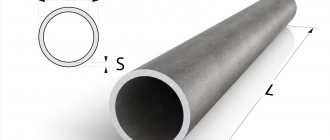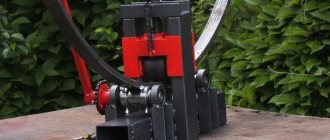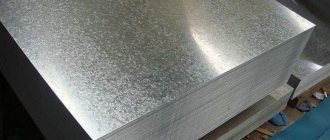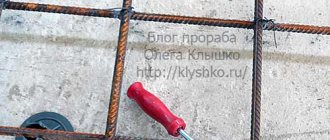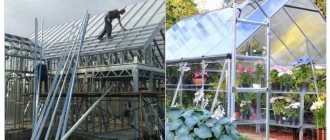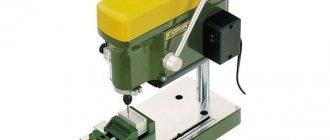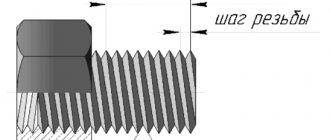03/19/2021 Author: VT-METALL
Issues discussed in the material:
- 4 main ways to weld pipes together
- Professional marking of pipes for subsequent welding
- Options for marking pipes before welding for beginners
- Types of corner joints
- Welding technology
- 3 methods of welding profile pipes at right angles
Welding pipes at an angle has its own nuances. It is somewhat more complicated than other methods of connecting structural elements. To do this kind of work well, a specialist must have certain knowledge and experience.
On the other hand, thanks to such welding, there is no need to use various kinds of bends, tees and crosses to assemble the pipe system. And it is simply unreasonable to miss this opportunity to save money.
Some tips for performing quality welding
The quality of welding depends on proper preparation for welding work, the choice of electrodes and process technology, which is somewhat different when connecting joints.
Selecting suitable electrodes
The quality of the weld largely depends on which electrode is used for welding. It is a thin metal rod with a special coating. The inner part of the electrode serves as a conductor to create an electric arc, and the coating ensures its stability and also participates in creating the weld.
Based on the type of core, electrodes are divided into consumable and non-consumable. In the first case, the product is based on steel wire, in the second - a tungsten, carbon or graphite rod.
Based on the type of protective coating, electrodes are divided into:
- cellulose - marked “C” - used for labor-intensive and complex welding work with large-diameter pipes, on long technological lines;
- rutile acid - “RA” - the most used type of electrode for welding water supply and heating utilities;
- rutile - “RR” - can also be used for welding water supply and heating pipes, they are distinguished by greater thickness and better quality of the weld;
- rutile-cellulose - “RC” - provide a more durable seam when using the vertical joining method;
- universal - “B” - suitable for welding pipes of various diameters and thicknesses, in a wide temperature range.
Another classification of welding electrodes is the diameter of the rod. The strength of the electric arc, which can cope with pipes of a certain thickness, depends on it:
- 3 mm – electrodes are suitable for welding pipes up to 5 mm thick;
- 4 mm – electrodes allow you to weld up to 10 mm thick, as well as make multilayer metal seams.
Attention! In addition to the thickness and material of the electrode, for high-quality welding it is also necessary to take into account the current strength, which depends on the method of connecting the pipes. For example, for a simple butt joint an arc from 80 to 110 amperes is suitable, but for overlap welding you will need to switch the machine to 120 amperes
Standards
There is a whole range of bends with different angles - 45, 60, 90 and 180 O. All of them are manufactured in accordance with GOST 17375-2001 from various grades of steel and meet all the requirements of reliability and strength. However, buying them can be quite difficult, especially when you live in a rural area and are far from large stores.
Standards for corner bends
GOST 17375-2001 implies the use of higher quality steel than in the manufacture of pipes, but for such diameters and for everyday tasks the material from which the pipes are made is quite sufficient. Such a 90-degree steel pipe bend carries all loads and serves no less than the main pipeline itself.
Angle according to GOST 17375-2001
How to deal with such a difficult situation and whether it is possible to make a bend with your own hands at home from scrap materials will be discussed in this article.
Selecting Electrodes
The preparatory stage includes the selection of the most suitable electrode. The quality of this consumable material determines the tightness of the resulting system, as well as the complexity of welding. Today, electrodes are used, which are represented by a conductive rod with a special coating. Through the use of a special composition, the arc is stabilized and a more attractive, high-quality weld is formed. Additionally, in some cases, the included chemicals reduce the likelihood of metal oxidation.
There are quite a large number of different versions of such consumables on sale. According to the type of core there are:
- With a core that does not melt. In their production, graphite or tungsten, as well as electrical coal, are used.
- With a melting rod. In this case, wire is used in manufacturing, the thickness of which can vary over a wide range. When carrying out electric welding, the thickness of the electrode is the most important parameter that needs to be taken into account.
Consumable Rod Electrodes
Classification is also carried out according to what substance is used as a coating. The most widely used versions are:
- Rutile acid is often used to create a heating pipeline system or supply water for domestic purposes. During electric welding, slag can form, which is not difficult to remove.
- Cellulose ones are more suitable for working with products that have a large cross-section. An example is the case of manufacturing a pipeline for supplying gas and water.
- Rutile is used when you need to get a neat seam. Removing slag from the surface is simple and quick. In addition, it is suitable for welding a second or subsequent seam.
- Rutile-cellulose is suitable for welding in almost any plane. This point determines their frequent use when creating a long vertical seam.
- The main coating is considered a universal coating that is suitable for electric welding of a wide variety of parts, including thick-walled products. The resulting fastener is characterized by plasticity and high strength.
Rutile electrodes
It is recommended to pay attention to products from well-known manufacturers, whose declared performance characteristics will correspond to real ones. In addition, when choosing consumables, you need to pay attention to the shelf life of the product.
Tapping methods without welding
You can cut into a main pipeline without using welding. This technology is used by many specialists, since welding work requires compliance with safety rules. In this case, special equipment will be required for welding. Welding work is considered complex and time-consuming.
Non-welding tapping technologies include:
- installing a collector is the optimal solution for a large private house. The compact collector system is also installed in the apartment. A water pipe is installed at the entrance of such a system. The collector has several outputs. Their number depends on the system model. The pipeline is connected to any outlet. Adapters are used to fix the hoses;
- installation of a tee - this insertion method is used if a single outlet is provided. The water supply connection is first unscrewed, and then a tee is installed in this place. The pipeline is expanded or shortened by cutting threads;
- the process of cutting the pipe itself - the technique is optimal if there is no external connection. A grinder is used to perform cutting. A tee with a pre-cut thread is installed;
- the use of a thin pipe - a hole is prepared in the system onto which a seal or clamp is fixed. To install the outlet, tightening screws are used.
Types of pipelines
Pipelines are divided into types based on the conditions of their use. Basically, the type is determined by the hazardous production facility at which they are used, as well as by the conditions themselves and the environment that passes through them.
The following types exist:
- Main oil, gas and product pipelines;
- Hot water and steam pipelines;
- Internal and external gas pipelines;
- Technological;
- Sewage and water pipelines.
I make pipelines from various materials, mainly: steels and alloys, as well as polymer materials. The article will not consider pipes made of concrete, ceramics and other non-weldable materials.
Carrying out work
Before starting welding work, you need to put on overalls, prepare a welding mask and gloves. Prepare the welding area. Remove all flammable items. You will need a metal brush to clean the surface of the pipe and a hammer to knock off the slag. And, of course, the welding machine itself, and correctly selected electrodes.
When purchasing electrodes, read the instructions on the package. The manufacturer shows on its product the operating rules and purpose of this type of electrodes. The electrode diameter and current strength are selected by calculation. For any 1 mm of electrode thickness, a current of 30 to 40 amperes is required. As for inverter welding machines, in this case for a 3 mm electrode the required current strength will be 80 A. These parameters are suitable for welding metal, but for cutting it you need to increase the current strength to 100 A.
You need to start the work by securing both pipes in order to avoid displacement of the seam. Light an arc with the electrode inserted into the holder and try to weld a small area. The electrode should have an inclination angle of 70? in relation to the surface to be welded and a gap of about 2–4 mm. It is immediately necessary to make a reservation that these indicators are very approximate and only experience will advise the optimal values in a particular case.
Before you decide to carry out work, you need to prepare as much as possible. It would not be superfluous to study the theoretical side of the issue, or watch relevant videos, or individual consultations with experts.
How butt seams are welded
If the edges are not beveled, the bead applied should have a slight flare on each side of the joint. To prevent lack of penetration, it is necessary to create a uniform distribution of molten metal.
Only the correct setting of the current and the competent selection of electrodes will allow for good welding of 6 mm metal if the parts do not have beveled edges. The current value is selected experimentally. Why are several test strips welded?
If the parts have V-shaped bevels, the butt weld can be a single layer or have multiple layers. The main role in this issue is played by the thickness of the metal.
When one layer is welded, the arc should be excited at point “A”, at the bevel boundary, according to Figure 67a. After which the electrode is lowered down. The root of the seam is completely boiled, then the arc is sent to the next edge.
When the electrode moves along the bevels, its movement is specially slowed down to ensure good penetration. At the root of the seam, on the contrary, they speed up the movement to prevent a through burn.
On the reverse side of the welding joint, professionals advise applying an additional weld seam.
In some cases, a 2-3 mm steel lining is mounted on the opposite side of the seam. To do this, increase the welding current by about 20–30% relative to the standard value. In this case, through penetration is completely excluded.
When the weld bead is created, the steel backing is also welded. If it does not interfere with the design of the product, it is left. When welding very important structures, the opposite side of the root of the weld is welded.
If you need to weld a multilayer butt seam, the root of the seam is welded first. For this purpose, electrodes with a diameter of 4–5 millimeters are used. Then the next layers are surfaced with expanded beads, for which large-sized electrodes are used (See Figures 67, b, c).
Need for work
Welding a pipe with water may be required in the following cases:
- Leaks formed as a result of exceeding standard loads or poor-quality installation work. Disconnection in such cases is not welcome, especially if we are talking about main pipelines supplying water to large residential areas.
- The need for a tie-in. Draining liquid from the entire system involves significant temporary losses, so the matter is often limited to turning off the circulation pumps. This measure helps reduce pressure in the circuit, making work easier.
Main difficulties
Welding pipes under pressure is not an easy task, and not every specialist will undertake it.
Problems are associated with the following phenomena:
- the pressure of the liquid does not allow the required temperature of the weld pool to be reached, it is extremely difficult to achieve the required coefficient of adhesion of the deposited metal to the base;
- When water comes into contact with hot material, large volumes of steam are produced. The welder has to work in conditions of limited visibility, the mask fogs up, he has to constantly wipe it, get distracted, waste time;
- It is very difficult to work when the pipes are located at a height, under the ceiling. Water can drip onto the welder, and it can be awkward to hold heavy equipment.
Welding and installation of a separate part of the pipeline system
When soldering a polypropylene water main, they always try to install individual sections of the water supply in a place with large free space and at a convenient height. To do this, you will need basic tools, a drawing of the highway and the correct procedure for carrying out the work.
Typically the hardest side to weld is on the wall with the two corner fittings, so it is welded first and secured with clips or dowel sleeves. Afterwards, from the corner fittings, further installation of sections of the line is carried out, moving on to soldering work directly near the walls. For ease of installation, it is necessary to provide in advance a place to install the soldering iron on a stand or organize its hanging.
What is needed for electric welding?
To weld pipes using electric welding, you will need a welding machine. Today there are two types of such devices: devices made on the basis of a step-down transformer, and inverters that operate at high frequencies. The first type is used extremely rarely, since it is considered obsolete. An inverter is a more modern device that is simple and portable. It is possible to regulate the welding mode with high precision. True, inverters are considered less reliable in use. Therefore, to work with such equipment you must have certain qualifications.
In addition, heating welding requires the presence of other auxiliary equipment:
- special mask with a light filter. It reliably protects the eyes and face from sparks and particles of molten metal during welding;
- body protection clothing;
- suede gloves. With their help, the device will be held securely in your hand;
- electrodes;
- metal brush. Necessary for cleaning the pipe section before welding, to remove scale;
- a special hammer that is used to knock down scale.
How to cut a pipe straight along
» Miscellaneous » How to cut a pipe straight along
In households, profile pipes are widely used in the manufacture of greenhouses, greenhouses, canopies to protect vehicles from precipitation and other structures. When working with this material, it is useful to know how to cut a profile pipe along a line or crosswise with the most accurate angle.
Among the large number of construction metal cutting tools, the leader in speed, ease of cutting and efficiency is the angle grinder (grinder), which is often present in the tool kit of any home craftsman. To cut a profile steel pipe using a grinder, you will need a regular metal disc and strict adherence to safety rules - breaking the disc into segments at high rotation speeds can lead to serious injuries.
Fig.1 Profile pipes in the household
Welding steel pipes
Welding of round pipes is carried out using a continuous seam. That is, if the process began from one point, then it should end at that same point, without lifting the electrode from the surface to be welded. When welding large-diameter pipes (over 110 mm), it is impossible to fill the seam with one electrode. Therefore, it is necessary to use multilayer welding, where the number of layers is determined by the thickness of the pipe walls. Eg:
- If the wall thickness is 6 mm, then two layers of metal are sufficient.
- 6-12 mm – welding is carried out in three layers.
- More than 12 mm - more than four layers.
Attention! Multilayer welding is carried out with one requirement. Before applying the next layer, the previous ones must cool down.
Pipeline assembly
Before welding pipes, to simplify the task, it is necessary to assemble the welding joint. That is, you install the pipes according to the assembly design, clamp them so that they do not move or shift. After which the tack is done. This is when spot welding is done in one place; if the pipeline is assembled from large-diameter products, then tack welding can be done in several places.
In principle, everything is ready, you can weld the pipeline. It would seem that this could be the end of the conversation about welding. But for novice welders it is just beginning, because the welding process associated with pipeline assembly involves a large number of nuances. Here are just a few of them that need to be taken into account.
- Pipes with a thickness of more than 4 mm can be welded using a root weld, this is when the metal fills the space between the edges to the full depth, and a roll weld, when a roller 3 mm high is formed on top of the seam.
- When connecting pipes with a diameter of 30-80 mm with a vertical seam, the technology is slightly different from the bottom location of the seam. First, the volume is filled to 75%, then the rest of the space.
- With multilayer welding technology, a horizontal seam is welded in two layers so that the next one is applied in the opposite direction than the previous one.
- The connection point of the lower layer should not coincide with the same point of the upper layer. The locking point is the end (beginning) of the seam.
- Usually, when welding pipes, the latter must be rotated all the time. This is done manually, so you need to know that the optimal rotation sector is 60-110°. It’s just that in this range the seam is located in a place convenient for the welder. Its length is the maximum, and this allows you to control the continuity of the seam connection.
- The most difficult thing, as many welders believe, is to turn the pipeline 180° at once and at the same time maintain the quality of the weld. Therefore, with such a rotation, it is recommended to change the welding technology. That is, first the seam is welded to a depth of up to 2/3 in one or two layers. The pipeline is then rotated 180°, where the seam is completely filled in several layers. Next, there is a 180° turn again, where the seam is completely filled with the electrode metal. By the way, such joints are called rotary joints.
- But there are also non-rotating joints, this is when pipe is welded to pipe in a fixed structure. If the pipeline is located horizontally, then the joint between its parts must be welded by dividing it into two parts. Welding starts from the bottom point (ceiling) and moves to the top. The second half of the joint is welded in the same way.
And the last stage in pipe welding technology is seam quality control. It must be tapped with a hammer to knock off the slag. Then visually check for cracks, gouges, chips, burns and lack of penetration. If the pipeline is intended for liquids or gases, then after assembly, water or gas is introduced into it to check for leaks.
The welding process is actually a responsible undertaking. And only the experience of a welder can guarantee the quality of the final result the first time. But experience is a gain. We invite you to watch a video on how to properly weld steel pipes.
Soldering polypropylene pipes in hard-to-reach places
When deciding how to solder polypropylene pipes in hard-to-reach places, the following factors should be taken into account.
Working with polypropylene pipelines in narrow places is more difficult than welding on straight pipe runs in conditions of sufficient space. Inconvenient places usually include areas near the top of the ceiling, spots in corners, and tight space conditions that make it difficult to install the soldering iron on the stand. In the latter case, you cannot do without outside help; an alternative solution is a special hook, prepared in advance in a convenient place, on which you can hang a soldering iron.
If the soldered pipe sections are located too close to each other on the wall, a special technique is used - the direct and mating parts of the joint are heated in turn. In this case, the first section is heated a little longer than the allotted time, and then the pipe is heated for a shorter time and, if possible, at a higher temperature (the regulator is set to a larger diameter).
The situation when the soldered sections must be of a certain length, but when welding them in line with a soldering iron, one of the parts will have to be cut to the width of two nozzles and a heating iron, can be solved in another way. A similar nozzle is purchased, fixed on the heating platform, and each of the segments is simultaneously soldered in different planes, after which they are connected. Using this method, you can mount not only straight sections, but also turns on walls, thereby ensuring a tighter fit of the line to the curved surface.
Rice. 4 Soldering polypropylene pipes in hard-to-reach places with an iron with two nozzles
READ ALSO: Magnetized Pipes How to Cook
Preliminary work with parts
According to the instructions, the following conditions must be met:
- Geometric dimensions.
- Availability of a quality certificate, in particular if it is a pipeline for drinking water.
- Perfectly round shape of pipes - no defects in the ends in the form of a flattened or oval section are allowed.
- The same thickness of pipe walls along their entire length.
- The chemical composition of products must comply with Russian GOSTs for certain systems. This information is obtained from technical documentation or laboratory tests.
Next, you can begin to actually prepare the pipes for joining and welding.
The preparation process includes the following stages:
- check the evenness of the cut at the end of the pipe - it should be 90º;
- the end and an area 10 mm from it must be thoroughly cleaned until a metallic shine appears;
- all traces of oils, rust, paints should be removed and the surface at the end of the pipe should be degreased.
This work can be done with a chamfer, trimmer or grinder. Professionals who work with large diameter pipes use milling machines or gas and plasma cutters.
Welding process
When all the preliminary preparation is over, you can start welding. If you do not have the necessary skills and have never performed such work before, we recommend that you first practice on extra pieces of pipe so as not to ruin the entire system.
Using a water container
What should we do if we are dealing with a small-diameter pipe, and we need to cut the pipe at an angle somewhere near the edge? A deep container filled with water will come to the rescue. Before you start working, you need to calculate the angle of inclination and make a mark on the container. Then all we have to do is carefully lower the edge of the pipe into the water and tilt it towards the mark on the container. We remove the pipe, mark the line of contact with the water, and boldly cut along the markings. This method is optimal when marking a huge number of pipes. A ready-made template from a container of water will speed up the process of our work.
Some tips for performing quality welding
The quality of welding depends on proper preparation for welding work, the choice of electrodes and process technology, which is somewhat different when connecting joints.
Selecting suitable electrodes
The quality of the weld largely depends on which electrode is used for welding. It is a thin metal rod with a special coating. The inner part of the electrode serves as a conductor to create an electric arc, and the coating ensures its stability and also participates in creating the weld.
Based on the type of core, electrodes are divided into consumable and non-consumable. In the first case, the product is based on steel wire, in the second - a tungsten, carbon or graphite rod.
Based on the type of protective coating, electrodes are divided into:
- cellulose - marked “C” - used for labor-intensive and complex welding work with large-diameter pipes, on long technological lines;
- rutile acid - “RA” - the most used type of electrode for welding water supply and heating utilities;
- rutile - “RR” - can also be used for welding water supply and heating pipes, they are distinguished by greater thickness and better quality of the weld;
- rutile-cellulose - “RC” - provide a more durable seam when using the vertical joining method;
- universal - “B” - suitable for welding pipes of various diameters and thicknesses, in a wide temperature range.
Another classification of welding electrodes is the diameter of the rod. The strength of the electric arc, which can cope with pipes of a certain thickness, depends on it:
- 3 mm – electrodes are suitable for welding pipes up to 5 mm thick;
- 4 mm – electrodes allow you to weld up to 10 mm thick, as well as make multilayer metal seams.
Weld joint quality control
Having completed the electric welding, an external inspection determines the presence of burns, pores, fistulas and other visible defects. To detect microcracks that are invisible to the naked eye, the mounted area is usually connected to the heating system. If water droplets do not appear on the seams, the work has been done efficiently. This method of checking is acceptable in a private home, where the system can be filled at any time.
In apartments with central heating, the quality of welded joints is checked in the summer using a compressor. Plugs are placed at the ends of the pipes, the joints are coated with soap foam, and air is pumped in under pressure. Places where there are flaws are identified by bubbles on their surface.
It is better to replace or install new heating pipes in the summer, so that most of the welding operations can be performed outside. There should be no flammable materials in the room near the place of work. If you still don’t have enough experience in welding pipes, you can first weld a few unnecessary scraps, so as not to spoil the new workpieces later.
Welding work
Experts believe that the easiest way to insert into a steel external network is welding. A prerequisite for insertion is the ability to turn off the water supply to the system.
An autogenous tool is used to make a hole of a suitable diameter. Then the pipe is welded and the valve is mounted. The last element of the system is covered during further work. If the tapping is completed, the anti-corrosion protection will need to be restored.
If the pipeline is laid from polyethylene pipes, then welding work is not carried out. Taking into account the diameter of the consumable, the clamp is fixed.
Welding process technology
To weld pipes, the following connection methods are used: electric arc (manual, semi-automatic and using flux) or gas (using acetylene).
Gas welding
Since it is not always possible to weld pipes using electric welding, in such cases a gas torch is used. This method is applicable in field conditions. At the same time, the quality and fullness of the seams is higher. The risk of internal stress in the metal is reduced, since it is less susceptible to temperature effects.
To carry out the work, a gas generator or acetylene is required. In the second case, the temperature in the working area is higher. The filler wire must be fed so that it is located on the hot metal. If welding of galvanized material is required, then flux is used, and the oxygen concentration in the gas increases. At the same time, it is not necessary to treat the seams with anti-corrosion agents after work.
Manual arc welding
When welding pipes using manual arc welding, the number of penetrations depends on the thickness of their walls. The composition of the electrodes is also important. If the diameter of the products is large, then applying the next layer removes the scale and forges the joint. When applying the first suture, do not rush. After this, the metal is checked for cracks. If there are uneven areas on the seam, they are cut out. Work in these places is carried out again with a displacement (1.5-3 cm). The finishing layer is made with thickly coated electrodes.
Indications for use
Gas pipe welding
Electric arc, argon arc or gas welding without beveled edges begins with adjusting the ends. The maximum gap between the pipes, in this case, is 1.5 millimeters, and the minimum is 0.5 millimeters. Moreover, this technique is used only on pipes with a wall thickness of 1 to 6 millimeters. The process itself begins with tacking the corner joint with spot welds, followed by straightening the position of the pipes and circumferentially welding the joint from the outside.
Angular mating with a one-sided end involves the formation of a chamfer at an angle of 50 degrees. A double-sided section involves the formation of two chamfers at an angle of 30 degrees. The gap between the edges in the first case is 1-2 millimeters, and in the second case 2-5 millimeters. That is, you can practically not worry about the accuracy of the ends. The wall thickness of pipes joined in this way ranges from 2 to 20 millimeters.
Angular mating with beveled edges and section involves joining pipes with a wall thickness of 6 to 60 millimeters. In this case, the width of the section ranges from 18 to 48 millimeters. Of course, such dimensions require a special technique for filling the weld pool.
Selection of electrodes for electric welded pipes
There are many types of electrodes suitable for various tasks and differing in material, thickness and characteristics. Before purchasing electrodes, you need to understand their features in order to avoid errors during operation. In addition, it is worth asking how to distinguish a fake product from a real one, and prepare for the costs - good electrodes are not cheap.
When connecting pipes, it is necessary to achieve not only high strength, but also a tight connection, for which you can use a simple method consisting of the following steps:
- The seam is not welded in a circle, but in the shape of a figure eight or horseshoe;
- During such welding, the slag from the metal is gradually squeezed out;
- Each piece of slag must be removed, the result will be not only a reliable, but also a fairly attractive weld.
How to cut lengthwise
Another frequently asked question is how to evenly cut a pipe lengthwise with a grinder. Here the algorithm of actions will be approximately the same as for transverse cutting
It is important to pay attention to marking. You can, for example, use painting thread, which is usually used when marking walls. In this case, it is necessary to firmly fix the pipe
The sawing process itself must be done carefully and slowly, since when sawing long elements there is a high probability of the cutting disc slipping from the marking line
In this case, it is necessary to firmly fix the pipe. The sawing process itself must be done carefully and slowly, since when sawing long elements there is a high probability of the cutting disc slipping from the marking line.
How to weld profile pipes at 90 degrees
To obtain a perfectly right angle when welding, the performer needs to have similar experience and strictly follow the technology. There are several important points that will help determine how to weld a profile pipe at 90 degrees:
- first of all, the pipes must be cut;
- work should be carried out on a flat surface;
- to fix the angle, you can use special devices (magnetic squares) or improvised means (corners or scarves);
- welding is carried out in stages: first, a rough connection is made; then the performer makes sure that the 90 degree angle is maintained; Afterwards the welding is completed.
Video
Here is a video of a simple device for welding at an angle of 90 degrees.
And here's another one, three-dimensional.
Features of soldering in corners
Soldering under such conditions is no different from carrying out similar work on other sections of the walls, with the exception of some factors.
Fillet welding requires precision and compliance with increased requirements for the geometry of a right angle; a square is used to check it. To join the sections, special corner couplings with a rotation angle of 90 degrees are used, which should be purchased together with pipes from the same manufacturer - this will ensure high adhesion between the connected elements.
Rice. 5 Sequence of soldering a PPR pipeline
Selection of welding electrodes
To choose the right electrode, you need to consider several important parameters:
- Workpiece thickness;
- Steel grade.
Depending on the type of electrode, the current value is selected. Welding can be done in a variety of positions. The lower one is divided into groups:
- Horizontal;
- Tavrovaya.
Vertical type welding can be:
- Down up;
- Ceiling;
- Tavrovaya,
Each manufacturer, in the instructions for the electrodes, must indicate the value of the welding current at which they will work normally. The table shows the classic parameters used by experienced welders.
The magnitude of the current is influenced by the spatial position, as well as the size of the gap. For example, to work with a 3 mm electrode, the current must reach 70–80 amperes. This current can be used to perform ceiling welding. This will be sufficient for welding parts when the gap size is much greater than the diameter of the electrode.
To cook from below, in the absence of a gap and the appropriate thickness of the metal, it is allowed to set the current strength to 120 amperes for an ordinary electrode.
Welders with extensive experience recommend using a certain formula for calculations.
To determine the current strength, 30–40 amperes are taken, which must correspond to one millimeter of the diameter of the electrode. In other words, for a 3 mm electrode you need to set the current to 90-120 amperes. If the diameter is 4 mm, the current will be 120–160 amperes. If vertical welding is performed, the current is reduced by 15%.
For 2 mm approximately 40 - 80 amperes are set. Such a “two” is always considered very capricious.
There is an opinion that if the diameter of the electrode is small, it means it is very easy to work with. However, this opinion is wrong. For example, to work with a “two” you need a certain skill. The electrode burns quickly and begins to get very hot when the current is set to high. With such a “deuce” you can weld thin metals at low current, but experience and great patience are required.
Electrode 3 - 3.2 mm. Current strength is 70–80 Amperes. Welding should be carried out using direct current only. Experienced welders believe that above 80 amperes, it is impossible to perform normal welding. This value is suitable for cutting metal.
Welding should start at 70 Amps. If you see that it is impossible to weld the part, add another 5-10 Amps. If there is a lack of penetration of 80 amperes, you can install 120 amperes.
For welding on alternating current, you can set the current strength to 110-130 amperes. In some cases, even 150 Amperes are installed. Such values are typical for a transformer apparatus. When welding with an inverter, these values are much lower.
Electrode 4 mm. Current strength 110-160 Ampere. In this case, the spread of 50 amperes depends on the thickness of the metal, as well as your work experience. "Four" also requires special skill. Professionals advise starting with 110 amperes, gradually increasing the current.
Electrode 5 millimeters or more. Such products are considered professional and are used only by professionals. They are mainly used for surfacing metal. They practically do not participate in the welding process.
How to weld a squeegee to a heating pipe? — Window Guru's Handbook
Pipeline installation is a serious and responsible undertaking. The welding process for connecting pipes is used quite often.
This method can be used to connect pipes made of various materials, but the process technology in individual specific cases will differ.
Electric welding of metal pipes is very widely used in industrial and private construction.
This method is distinguished by its simplicity, mobility and economic profitability, as it can be carried out both manually and automatically. In private construction, manual arc welding of pipes is most often used, for which it is enough to have welding equipment and electrodes.
Types of welded pipe joints
In construction and industrial production, the following methods of welding steel pipes are used:
- butt welding;
- overlap welding;
- welding of T-joints;
- welding corner joints.
When making connections by welding, the following positions are used, depending on the conditions: horizontal, vertical, bottom and ceiling. The most advantageous and convenient welding position is the lower position, which is possible by rotating the pipe, so preference should be given to this technology.
When constructing large-diameter pipelines, butt joints are most often used.
In such cases, it is extremely important to ensure that the edges are welded throughout the entire thickness.
For thick-walled pipes, double welds are used - external and internal.
To reduce the formation of metal deposits on the inner surface of the pipes, it is necessary to hold the electrode at an angle of 45 degrees relative to the horizontal plane during the welding process.
Range of welding electrodes
Before welding a pipe to a pipe, it is necessary to choose the right electrodes, which are available with different types of coatings, and each type is capable of performing a specific task, which should guide your selection.
- Cellulose coating. This type of electrode is used to weld large-diameter pipes; they are capable of creating circular and vertical seams.
- Rutile coating. Electrodes with such a coating have easy ignition and re-ignition, and the slag crust is characterized by a high degree of fragility. It is very convenient to install tacks, make corner seams and weld root seams on top to create a marketable appearance.
- Rutile-cellulose coating. Such electrodes are convenient for making seams in any position in space, including in the vertical direction, which is the most difficult according to specialists.
- Rutile acid coating. Provides easy separation of slag crust and economical consumption of electrodes when welding pipes.
- Basic coating. Electrodes with such a coating provide the welding seam with high viscosity values. Such seams are not subject to cracking and are used for thick-walled pipes with difficult operating conditions. It is also recommended to use when using pipelines at low temperatures.
Sections: Welding work - how to cook
performing welding work, do-it-yourself welding, Welding - basics
Mistakes when soldering plastic pipes
An inexperienced plumber or owner who decides to carry out the installation of a polypropylene water line with his own hands often makes mistakes, not fully knowing the technology of pipe soldering and not knowing how to work with a soldering iron.
The most common errors include the following.
Rice. 8 Differences between budget and expensive irons
Wrong choice of soldering iron
The most popular and inexpensive devices for soldering are electric couplings with attachments for different diameters of PPR. When purchasing and using, you must consider the following factors:
- You need to purchase the device with a convenient holder so that you can easily and quickly install it in place when working independently. This will reduce the time that heated elements are in an undocked state, which can lead to cold welding and further depressurization.
- It is also better to choose the units used with the regulator and power buttons placed in such a way that you do not touch them with your hand during operation, thereby lowering the temperature or turning off the heating.
- If the device is used for regular use, it is better to purchase an expensive model with high-quality Teflon nozzles - this will prevent polypropylene from sticking and improve the quality of connections.
Rice. 9 PPR heating table
- Modern devices are produced with electronic indicators that maintain a constant temperature using a built-in processor, which is reflected on its display. This factor also helps to improve the quality of soldering, the time of which is determined based on the degree of heating of the couplings, which cannot be determined on old-style units.
- The device must maintain a given temperature, which increases with increasing pipe diameter. Many Chinese irons have high temperature parameters, which should be taken into account when choosing a manufacturer; Turkish-made models are considered to be some of the best units in terms of price and quality ratio.
- The shape of the iron and the location of the couplings play an important role in cases where polypropylene pipes are welded in hard-to-reach places. A narrower iron and placement of the couplings on the edge of the pointed end in this case are much more convenient to use.
Repay
Overexposure of elements in the soldering iron for more than the required time leads to their surface overheating and after connection, accompanied by excessive force, the pipe passage becomes clogged with molten plastic. If such an error occurs at a large number of joints of heating or water pipelines, the system will not be able to function normally. In order to avoid this situation, you should strictly follow the time intervals specified in the instructions for each type and diameter of pipes and carry out several test solderings of small sections.
You should also always clearly mark with a pencil the distance to which the pipe is deepened for a diameter of 20 mm. it is usually 14 - 17 mm.
Low heating, incorrect angle and other errors
Many beginners make a fairly large number of mistakes, which include the following:
- Soldering of dirty elements near the walls or with water remaining in the line, while due to dirt or water cooling, the plastic does not connect well and subsequently depressurization of the joint occurs.
- Insufficient deepening of pipes into sockets of larger diameter. It often occurs when there is a minor error in the installation of faucets - if its valve is not turned at a small angle, the air in the joined area will not have an outlet, preventing the mounted area from being completely immersed in the hole.
- If the elements being connected are not heated sufficiently, the plastic will not have a uniform structure and the joint will depressurize. This defect can be identified by the absence of a skirt at the edge of fittings with a large diameter.
- When manually joining elements, a single axis must be maintained - otherwise distortions will lead to insufficient density and depressurization.
- Also, after joining, the joined area should be kept motionless for a certain time until it cools completely.
Rice. 11 Method of repairing polypropylene pipes by heating the surface of the pipe being repaired with a nozzle
To ensure high-quality soldering of polypropylene pipes in hard-to-reach places, you need to choose the right soldering iron - the model should provide easy access and the required heating temperature without sticking of the PPR. For convenience, all work is divided into two stages - first, long chains are installed in a convenient place, and then they move to the walls, joining sections in weight.
]]>
